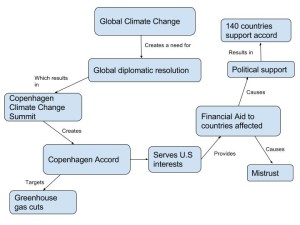This diagram illustrates the process behind the Copenhagen Accord, beginning with the overarching problem of global climate change. Climate change fosters the need for global and diplomatic change, which happens at the Copenhagen Climate Change Summit in 2009. At this summit, the Copenhagen Accord is created to cut greenhouse gas emissions, but that cannot be guaranteed, which is why the term “target” was appropriate here. Signing a global treaty on climate was a difficult task, and many countries needed persuading. The accord ultimately worked in the United State’s favor, which is why the US provided financial aid to countries who were affected by climate change. This either caused mistrust and skepticism on whether this compensation would actually happen, or it resulted in political support. 140 countries declared association to the treaty, which falls in favor of their 100-150 country target.
In my own opinion, I am someone who cares deeply about climate change and understands the urgent need for solutions. It concerns me that some people still believe climate change is a myth. Although I do not necessarily agree with the threats, spying, and overall corruption that seemed to take place under wraps, I’m not entirely surprised. Negotiating a solution to climate change with over one hundred countries in the mix is bound to cause issues. I think it is beneficial that the cables were made public because it is very eyeopening to see how countries behaved in this situation, especially the United States. I’m not surprised by the United States policing other countries in order to reap the benefits since we are a huge influence on global diplomacy. I agree that it was crucial for this accord to be signed, but threatening, hacking, spying, and promising money that may or may not be seen is not the most ethical way to go about it. It may be extremely unrealistic, but negotiations should be genuine and made with purpose to benefit all countries involved. For example, in order to get a country to sign the treaty, the US could have provided solar or wind energy sources to that country. If the US was going to provide millions of dollars in financial aid, they could put that money towards something that would help solve climate change. This problem ultimately comes down to ethics, and I think the US handed this in an unethical way.


Hi, my name is Baixue Chen , and below is the link to my blog. If you are interested you can have a look. Your post catch my attention because you say someone still believe climate change is a myth. This remind me about Donald Trump, the presidential candidates of United States. He wrote on twitter “The concept of global warming was created by and for the Chinese in order to make U.S. manufacturing non-competitive. ” Well“““`I think he not only misunderstands climate change but also Chinese““““ http://geog030.dutton.psu.edu/2016/04/06/climate-change-2/
Hi Katie, this is Akiksha, currently a freshman here at University Park. Your post caught my attention because it is somewhat similar to mine. I agree with you that the means used were not justified, however it did help in the climate change situation. I like how you’ve explained it through the diagram that there was a need to address this issue which is why the Copenhagen Accord came up and later led to mistrust issues and skepticism. In my post, I say the same that the US did wrong, though there was some benefit from it, hence leaving the past we should concentrate now on working together and solving this problem.
Here is a link to my post : http://geog030.dutton.psu.edu/2016/04/06/copenhagen-accord-boon-or-bane/ . I hope you go through it too.